The Insider
Social workers get LAPD backup
September 22, 2010
Attention, county child social workers: the LAPD is riding with you now.
The city police department just became the first non-L.A. County agency to supply case information to a computer database called the Family and Children’s Index that aids social workers launching emergency child-welfare investigations.
“This is groundbreaking,” said Carlos Pineda, principal analyst in the Chief Executive Office’s service integration branch, who is directing an expansion and improvement of FCI that began last year in the wake of several highly-publicized children’s deaths.
The LAPD deal was finalized as the Board of Supervisors approved a memorandum of agreement this week between County CEO William T Fujioka and LAPD Chief Charlie Beck that enables the department to begin entering data on thousands of cases into the FCI database.
The database provides emergency child social workers from the Department of Children and Family Services with a quick overview of how a family stands with legal, mental health and other government entities as they launch emergency investigations into allegations of child neglect or abuse. It uses a “pointer” system that lists the existence of relevant contacts or cases for family members, and provides a contact at each department for social workers to call for more information.
Until now, the system’s law-enforcement data has come solely from the Sheriff’s Department, covering county unincorporated areas and contract cities such as West Hollywood and Malibu. (The District Attorney also inputs information from prosecutions.) The infusion of data from the LAPD, covering the city’s 4 million residents, should more than double the number of law enforcement cases flagged in FCI, said Garrison Smith, the CEO’s chief point man on FCI.
The one-year agreement will cost the county $37,500 in operating costs. County officials hope that if the program is successful, it can be renewed—and expanded to other police agencies.
“If the LAPD agreement becomes a template, there are another 45 police agencies that potentially could participate,” including those in Long Beach, Santa Monica, Burbank and Glendale, Pineda said.
The LAPD agreement is the latest in an ongoing reform effort to step up the quality and utility of FCI. Despite being in place since the mid-1990s, the system was consistently underused because key agencies were not entering relevant data regularly.
Last year, supervisors directed that participating county agencies re-train workers in the use of FCI to improve the entry of key information, and to ensure that DCFS social workers tapped into the system before launching investigations. In addition, agencies have made staff available to field social workers’ inquiries around the clock. And the county’s Department of Health Services is now taking part in the data entry program.
The efforts seem to be boosting usage of the system. Over the past year, the number of queries doubled, from 13,700 last summer to 27,500 in August.
FCI may get another expansion soon if, as expected, Gov. Arnold Schwarzenegger signs Assembly Bill 2322 into law. The bill would broaden FCI to include data about child-welfare convictions by any member of a child’s household, not just family members. The additional data is important because emergency cases can involve potential abuse or neglect by, say, a mother’s live-in boyfriend.
Despite the improvements, the system still experiences lag times.
“I know from personal experience that responses are seldom immediate,” Mike Ross, a supervising children’s social worker at DCFS, told supervisors at Tuesday’s meeting. “FCI is only as good as information in the social worker’s hand when he is making life or death decisions about the child.”
Posted 9-22-10
Bell tax refunds not money in the bank
September 15, 2010
 Los Angeles County’s auditor-controller has a message for the city of Bell: Show me the money.
Los Angeles County’s auditor-controller has a message for the city of Bell: Show me the money.
Late Wednesday, Wendy Watanabe urged Bell in writing to promptly transfer $2.9 million to her office so refunds can be sent to homeowners whose property taxes were illegally hiked during the past three years.
“The refund process to Bell taxpayers is a high priority for Los Angeles County…and we look forward to your cooperation,” Watanabe said in a letter to Bell’s interim city administrative officer, Pedro Carrillo.
Watanabe’s letter was prompted by a surge of calls from Bell residents this week after state legislation was signed that cleared the way for the refunds, which otherwise would have gone to the city’s schools. The callers wanted to know when the checks would be hitting their mailboxes. Their expectations were raised when the bill’s author, Assemblyman Kevin DeLeon (D-Los Angeles), said the refunds could be mailed within a week.
Watanabe said she was driving to work when she heard that hope recounted by KFI radio host Bill Handel. “I said to myself, ‘Excuse me? Are you processing the payment? Are you paying?’ I almost stopped the car and called.”
“The auditor-controller does not have the authority to front the money,” she said. “I’m sympathetic but I’m not in any position to do so.”
Put another way by Watanabe’s top aide on the issue, Arlene Barrera: “We don’t have money just sitting around.”
Under the new law—signed Monday by Lt. Gov. Abel Maldonado because Gov. Arnold Schwarzenegger was in Asia—Bell has until December 31 to transfer the funds to the county. The auditor-controller’s office, however, has been pushing behind the scenes for a faster resolution to help Bell’s homeowners, who’ve been complaining for years of exorbitant property taxes.
In fact, despite Bell’s largely lower-income population, its tax rate is the second highest in L.A. County—higher even than Beverly Hills. (See earlier story here on Bell’s attempts to undermine a resident’s meeting with county officials.)
The resident’s complaints finally got traction in July, when the Los Angeles Times revealed the scandalously high salaries of Bell officials, prompting a number of official investigations, including one by State Controller John Chiang. He determined, among other things, that Bell homeowners for the last three years had been charged for pension obligations that exceeded the legal limits.
In her letter to Bell, Watanabe said her office had thus far identified 4,772 Bell residents who continuously owned homes and paid property taxes during the past three years, making them eligible for full refunds of the unlawful levied charges. The remaining 1,258 properties, she said, have changed ownership during that period, meaning that the refunds will have to be pro-rated between the current and previous owners.
So far, despite official and back-channel conversations, Bell has yet to tell the auditor-controller’s office when to expect the $2.9 million.
“They said they’d let us know as soon as possible,” Barrera said.
Posted 9/15/10
County crackdown on numbers racket
September 2, 2010
Identity thieves, meet Kai Ponte.
Ponte is overseeing an unprecedented technological effort by Los Angeles County to conceal Social Security numbers on millions of documents filed with the Registrar-Recorder/County Clerk during the past 30 years.
The project, mandated by California law, is aimed at protecting consumers by depriving crooks of information they can use to steal identities and inflict havoc on the lives of their victims. Social Security numbers—once routinely included on many kinds of official documents—are highly prized in this world of high-tech theft.
Ponte, who supervises the management systems team in the recorder’s office, understands the stakes and offers this warning to the growing legions of rip-off artists: “Go look somewhere else because you’re not going to find anything here.”
The state law, which went into effect last year, was authored by Assemblyman Dave Jones of Sacramento, a longtime advocate of consumer privacy legislation. To make his point on the need for this one, he initiated a public records search of some of the elite of Sacramento’s business community.
“We pulled up a wealth of information, including their Social Security numbers, which experts repeatedly told us was the most important piece of information to have if you wanted to steal someone’s identity,” Jones says. “We didn’t name names because we didn’t want to have a race to the recorder’s office by identity thieves, but we did mention the people by category—a CEO, a prominent developer, a banker.”
No one, of course, could have predicted decades ago, long before the Web revolution, that the millions of documents being filed with counties could some day become gold-plated invitations for criminality. Dean Logan, Los Angeles County’s Registrar-Recorder/County Clerk, says the redaction project was crucial in making records of the past safe for an age in which so much personal information is accessible through online databases. Although the law covers documents dating back to 1980, Los Angeles County is beginning with 1977.
“What we’re doing is balancing the purpose of maintaining a public record while eliminating the risk that it can be used to steal somebody’s identity,” Logan says, adding that, for the most part, complete Social Security numbers no longer appear on documents filed with the recorder’s office.
Under the new law, every county recorder is required to keep an unaltered “official record” and a “public record” that masks the first five digits of a person’s Social Security number.
“Most counties thought, ‘We’ll just make two copies,’ ” Ponte says. That’s an easy fix for a county like Modoc, which handled only 3,286 documents last year, Ponte says. “But in L.A. County we do between 2 million to 3 million annually, so we certainly didn’t want to create two copies.”
To that end, Los Angeles County launched the most technologically sophisticated strategy in the state to conceal Social Security numbers—a strategy that got a boost this week when the Board of Supervisors approved a key contract worth potentially as much as $821,370. Under that contract, Neubus Inc. will make digital copies of 20 million pre-1992 documents that now exist only on microfilm.
This digital conversion is essential to L.A. County’s unique approach. Instead of making a duplicate set of records like other counties, officials here will use software that searches documents for Social Security numbers and then automatically masks them before the record is viewed by the public. The old microfilmed documents can’t be altered unless they’re converted into digital files. The 50 million documents filed since 1992 already are digitized.
In all, Ponte estimates that of the tens of millions of documents that will be scanned, about 10 percent of them will have Social Security numbers that need to be masked. Virtually all these documents are related to property transactions of various sorts. Registrar-Recorder officials estimate that the project could take up to five years to complete.
As for the program’s cost, it’s being covered by a fund created through the state law and fed by a $1.00 fee the county collects on each recorded real property document. In other words, says registrar-recorder Logan, “we’re not taking something away from the general fund at a time of fiscal crisis.”
Logan also noted that, given the bad rap that public officials sometimes deservedly earn, projects like this one—designed entirely with the public’s protection in mind—“should make people feel good about their government.”
Posted 9/2/10
With this job, she doth wed
August 19, 2010
Portia Sanders has been left at the altar again.
Just days ago, she was downing Monster energy drinks and orchestrating the dizzying logistics of joining in holy matrimony an expected surge of gay and lesbian couples across Los Angeles County.
A federal judge, who ruled that Proposition 8 was unconstitutional, had cleared the way for same-sex marriages to begin on Wednesday evening after a ban of nearly two years. As division manager of public records for the county’s Registrar-Recorder/County Clerk, it was Sanders’ job to make sure the couples were hitched without a hitch.
Plans were well in the works to install partitions in an executive conference room at the Norwalk headquarters to create seven “small chapels” for the exchange of marital vows.
And Sanders, although anxious about the many tasks ahead, was excited about a repeat of the experiences she’d had with same-sex marriages back in 2008, before the passage of Proposition 8.
“That was one of the most rewarding times of my career,” says Sanders, who has worked for the county for 24 years. “There was so much love, so much happiness. Even the most conservative person couldn’t help shed a tear. There were no ‘tough guys’ anywhere.”
But for now, Sanders, who was planning on performing a few marriage ceremonies herself, will have to wait for another one of those career highlights. Late Monday, she got the word that a three-judge panel of the 9th U.S. Circuit Court of Appeals had imposed an emergency stay of the trial court judge’s ruling. The impact: same-sex marriages will be on hold until at least December.
“I’m disappointed because people don’t have the right to do what they want to do. That’s my personal opinion,” says Sanders. But, by now, she knows that marriage deferred is not necessarily marriage denied. “At least the delay gives us more time to fine-tune.”
To date, most of her planning has centered on making sure there are enough staffers to process licenses and perform ceremonies in Norwalk and at a half-dozen field offices, a task she says may be tougher around the December holidays. Sanders says she has had to draw employees from, among other places, the real estate division. She also has juggled assignments for a small number of employees who, citing religious views, have said they do not want to perform same-sex marriages.
“This is part of their job but we cut them some slack in performing the ceremony. We have them type up marriage licenses,” Sanders says, stressing that each request is carefully examined.
For the most part, L.A. County marriage ceremonies are conducted by volunteers, who are deputized by the registrar-recorder’s office. According to Sanders, some are retired men whose wives have told them to spend more time outside the house. Others, she says, might hold emotionally challenging jobs, such as working in a hospice, and enjoy the lift they get from joyful marriage ceremonies. “It evens it out for them,” says Sanders, who says the department is always seeking more volunteers to perform marriages—same-sex or otherwise.
In some respects, Sanders says she expects the next round of gay marriages (should they occur) to go more smoothly than in 2008. The marriage license itself, for example, has already been changed and integrated into the system. It no longer asks for the name of the “bride” and “groom.” That’s been changed to “first person” and “second person,” Sanders says.
She suspects, however, that one thing will remain the same—the “very reverent” attitude the participants brought to the ceremony. “They didn’t want anyone thinking they were making a mockery of marriage.”
Posted 8/19/10
L.A. lifeguards runaway winners—again
August 10, 2010
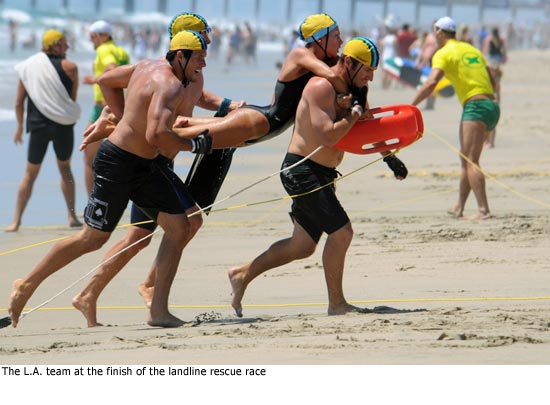 Los Angeles County lifeguards boast an athletic dynasty that even the New York Yankees can’t touch.
Los Angeles County lifeguards boast an athletic dynasty that even the New York Yankees can’t touch.
The county team swamped the competition at the three-day National Lifeguard Championships last weekend in a swirl of swimming, paddling, running and water rescue work—for the 24th straight year.
L.A. hasn’t lost the team title since 1986. Since the U.S. Lifesaving Association launched the event in 1970, they’ve captured that title an amazing 37 out of 40 times.
“People were in awe of what we were able to do,” says Capt. Jay Butki, one of the team’s managers. “We’re ecstatic.”
The final team score at this year’s competition at Huntington Beach wasn’t close. The L.A. team scored 812.5 points. The second place squad, from Delaware, finished with 223.75.
“Most likely, we’ll never lose this title,” says Brian Murphy, who won the men’s open championship and is stationed in Santa Monica.
The L.A. County team was so dominant that it also claimed six of the top 10 spots in both the men’s and women’s individual competitions.
The No. 1 woman was Alison Riddle, 24, who won 5 of the 8 competitions she entered, including the iron woman, a combination of running, board paddling and swimming.
 “It was awesome,” says Riddle, who savored her ironwoman victory the most. “It’s such a long event and that makes it really tough.”
“It was awesome,” says Riddle, who savored her ironwoman victory the most. “It’s such a long event and that makes it really tough.”
Making life tougher were water temperatures that didn’t feel like summer. “The water was so cold it gave you an ice cream headache,” she says.
Riddle joined the Lifeguards in 2008, shortly after graduating from USC, where she played varsity water polo. Her weekend victories netted her medals and a pair of sunglasses for each victory. But, in her business, not even champions catch a break: Riddle reported for her regular shift on Monday at 7 a.m. at Redondo Beach’s Avenue C tower.
Riddle, who finished ninth as a rookie in last year’s championship, says she owes much of her success to a trip last winter to train in Australia, where she worked hard on paddle boarding. “To be able to learn from the best in the world was amazing,” she says.
Murphy, the men’s champion, won three events—paddleboard, surf ski and the so-called Taplin relay, a team medley race that involves swimming, paddling and rowing. The 27 year old grew up in the South Bay, with three older brothers who also became lifeguards. He signed up at 18. (He still competes in team events with his brother Mike.)
Murphy remembers being in awe as a little boy at lifeguard competitions. “I grew up watching all these guys race, and now I’m lucky enough to do it myself,” he says.
Riddle and Murphy can’t rest on their victories. Next month, they’ll be jetting to Japan, part of a 12-person national team that will include four other L.A. lifeguards.
The secret to L.A.’s dominance partly involves size. It’s the nation’s largest lifeguard service and hosts the biggest team, with 57 competing this year among the 450 from around the country.
Peak physical conditioning is another L.A. tradition.
“That’s one of the things we pride ourselves on,” says Capt. Chris Linkletter, a team manager and competitor who practices what she preaches. She won a 2K run in the 40 to 44 age bracket and finished second or third in six other events, including two different ironwoman competitions.
The team’s strong representation in the older age categories is a key to the team’s dominance, team members say. They routinely do extraordinarily well in all of the over 30 age brackets, a fact no one knows better than this year’s most senior competitor, John Matesich, 72.
Matesich, a county lifeguard for 49 years, won all of his three events in the over-70 bracket, including the board race and men’s ironman.
“He’s been a legend forever,” says Butki.
So, it seems, has the L.A. team.
Posted 8/10/10
Framing a career
July 21, 2010
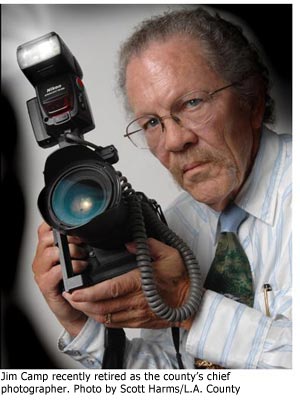 When Jim Camp joined Los Angeles County’s photo staff, he drew a royal flush—with emphasis on royal.
When Jim Camp joined Los Angeles County’s photo staff, he drew a royal flush—with emphasis on royal.
In his 34 years of service, Camp photographed the Queen of Thailand (“Funny story about that,” he said, describing the perfect protective triangle formed around her by three ladies in waiting.) And the King of Samoa (“Funny story, too,” involving men in skirts and tuxedo jackets with machine guns.) And assorted British royals from Prince Philip and Prince Charles to Fergie, the Duchess of York.
There was Hollywood royalty, too, like Kirk Douglas, as well as presidential royalty, from Ronald Reagan to Bill Clinton.
And, of course, there was another kind of king. By which we mean Kenny Hahn.
“He was the king of the photographs,” Camp said outside the Hall of Administration after receiving a scroll Tuesday honoring his years of work and congratulating him on his recent retirement. The late supervisor Hahn was actually part of Camp’s first photo assignment for the county: “It was the Greek Orthodox Pope, and he landed at LAX and Kenny Hahn was there to meet him.”
On Tuesday, after years of shooting countless “grip-and-grins,” showing up at infinite numbers of rubber chicken dinners and shadowing some of the most powerful local politicians in the world as they interacted with the great and near-great, Jim Camp was suddenly on the other side of the lens.
And he didn’t much like it.
“I didn’t want to do it because basically I don’t like that side of the table,” he said. “I’ve spent too many years on the other side. But Mike wouldn’t let me go.”
That would be Supervisor Michael D. Antonovich, one of 12 county supervisors whose every public move has been chronicled by Camp and his staff during the course of his county career, which started in 1976.
Antonovich publicly praised Camp for his “excellent service and dedication” to the county and cited some of his biggest accomplishments: overseeing the county’s transition to digital photography and beginning the process of archiving its “irresistible historical images.” As chief photographer, Camp supervised a unit with three photographers and two student workers.
But the heart of the job was interacting with the supervisors themselves—and witnessing the worlds they walk in.
“They’ve each had their goods, their bads, their little secret cues for us,” Camp recalled. He said that whenever Hahn would say “Just do the best you can,” he actually meant something like “Stop fussing and just shoot the picture already.”
“Good Lord, some of the stuff was just incredible,” Camp reminisced Tuesday, before launching into one of his trademark anecdotes, this one about a demonstrator who rushed the Board of Supervisors at a meeting but was stopped cold after he crashed headlong into an enormous sheriff’s deputy blocking his way. “It was one of these deputies who are wider than they are tall,” he said. “He picked [the demonstrator] up by the belt and walked out of the room with him.”
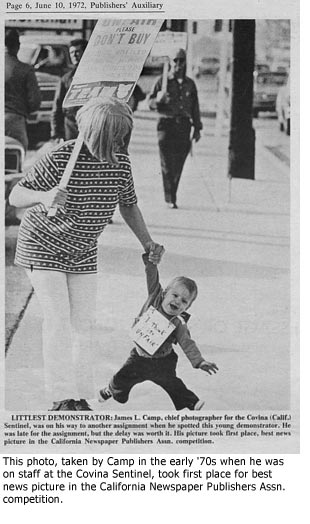 So did that turn into an action photo of government at work? No way. “We had to be careful what we shot and what we didn’t shoot. We were there to cover the board, not news.”
So did that turn into an action photo of government at work? No way. “We had to be careful what we shot and what we didn’t shoot. We were there to cover the board, not news.”
It was a big transition for someone like Camp, now 71, who’d been a photographer for the now-defunct Covina Sentinel and the San Gabriel Valley Tribune before joining the county.
“When I was shooting news, I shot what I wanted,” he said. “Now I had to make the board members look good, no matter what.”
There were perks, of course—like being selected to photograph Reagan’s visit to the county in 1982 and being assisted by a Secret Service agent who helped him navigate walking backward down a hall while shooting photos every step of the way. “His job was, I guess, to keep me from making a fool out of myself.”
Camp was born in Michigan but grew up in California. He joined the Navy right out of high school and spent 59 days in a submarine submerged off the coast of Vladivostok during the Cold War (but that’s another story). He started with the county as a microfilm technician, and first came to the photo department on a temporary assignment. He worked a lot in the lab at the beginning but soon enough was out shooting photos, day and night.
It was the kind of schedule that could wreak havoc with the home life.
“What home life?” Camp said. “Eight to five every day, plus nights, weekends, holidays—whenever we were needed…”
“We were headed to Wyoming for one of my rare vacations, and they ran out of people to shoot an event out in Newhall,” Camp said. “I packed up the family in the camper but I stopped in Newhall and shot the event.”
Camp’s wife, Diane, who was in the audience for Tuesday’s presentation, served as his “reality check” during all those years of service, including times when “I’d get wound tighter than a tick.”
Also present Tuesday was his 15-year-old grandson Nick, who lives with Jim and Diane in Glendora.
Camp thanked his county family and his actual family for “making quite an adventure out of this.” And then he stepped outside to talk about what’s next—more time for another kind of shooting (target practice) and to finally purchase a piece of equipment that the county had provided for so many years.
“I’ve got to buy a camera,” he said.
Phone audit delivers wake-up call
July 14, 2010
Here’s one phone number Los Angeles County officials would rather forget: $3.5 million.
That’s how much money was being spent annually on unused phone lines across the county bureaucracy—20,906 of them—according to a new report by the county’s Chief Executive Office.
CEO William T Fujioka said the amount spent on these lines could rise to as much as $4 million as the county moves toward completing its “zero usage project,” part of a multi-faceted initiative to reduce waste and inefficiencies.
Fujioka said he knows the county is open to criticism for not recognizing sooner that unused lines were a potential source of wastefulness. “But the worst thing that could have happened,” he said, “is that the audit would not have happened at all.”
The phone line audit targeted every agency, big and small, of Los Angeles County government. In some instances, the savings amount to just a few hundred dollars, as in the case of the Office of Ombudsman, which disconnected service to two of its total five lines, saving $339.12 a year.
Then there’s the massive Department of Public Social Services, which so far has cut service to 3,791 lines out of 6,633, for an annual savings of $600,478. (For the complete rundown of department savings, click here.) DPSS Director Philip Browning said that while some of the unused lines can be traced to office moves and the loss of 1,000 staffers, complacency also is to blame.
“I think we take so much for granted,” said Browning, who praised the county’s focus on waste. “When times are tough and budgets are tight we’re forced to think about things in a different way. We don’t have the luxury to continue in the same way as when things were better.”
Browning said the audit put even him on the spot. When he moved into his office after being appointed a few years back, there were two phones, one of which rang only when it was a wrong number. “I never even thought about it,” Browning said. “I’m sure there was a good reason at some point in time for someone to have both phones. It could have been years and years ago.”
Credited for coming up with the audit idea is Thomas Tindall, director of the Internal Services Department. His agency pays the bills for the county’s roughly 200,000 lines. Tindall, who helped prepare the CEO report, called the phone study a “good news, bad news, kind of thing” because, although the county aggressively uncovered the problem, it should have been discovered earlier.
“I really cringed when I had to prepare the [CEO] memo because I knew the media might be calling,” Tindall said.
The study was a huge and time-consuming undertaking, with every department being given a list of numbers for which there’d been no “outbound usage.” Then, it was up to the departments to determine whether the lines were being used—a task not quickly embraced by everyone, said Robert Aragon, who managed the project for ISD.
“I would say it was viewed as a lower priority,” Aragon said. “What ultimately helped, the CEO’s office applied some pressure and told them to get it done.”
And that push may help get them ready for what’s on deck.
“Next, we’re going to look at printers. We have over 70,000 of them,” said CEO Fujioka, adding that toner doesn’t come cheaply.
Posted 7/14/10
Money for arts, shorter holiday show
July 8, 2010
If you’re already sick of summer and have started counting the days till L.A. County’s free Holiday Celebration, we have some news for you: This year’s musical extravaganza will be shaving three hours off the usual six-hour running time.
In other words, a little less “Nicholas Nickleby,” a little more “Muppet Christmas Carol.”
The show will go on—albeit in reduced form—for other arts programs, too, thanks to an infusion of $731,000 from the Board of Supervisors on Tuesday. The board acted to restore funds previously cut from the Arts Commission budget. In addition to providing funding toward the Holiday Celebration, an array of local arts institutions will see their county grants cut only 7%, instead of 13%, because of the additional funds, said Arts Commission Executive Director Laura Zucker. And a chunk of the money is going toward summer arts internships, allowing the program to continue next summer on the same limited basis as this year.
“It’s good news,” Zucker said, “but I don’t want to give the impression that the arts are escaping their fair share of reductions…This [funding infusion] mitigated steeper cuts.”
Zucker noted that 90 of the 166 organizations receiving grants will be using the money to directly support jobs.
“Anything that we can do to soften the blow to these nonprofits is important,” she said.
As for the Holiday Celebration, the shorter running time means that only 22 or 23 performing groups—instead of last year’s 45—will be able to take the stage at the Dorothy Chandler Pavilion. And the show will be televised only locally, not nationally. The production, founded 50 years ago by the late County Supervisor Kenneth Hahn, traditionally showcases a wide variety of musical and dance groups, from barbershop quartets to klezmer and mariachi performers.
The cost to put it on last year was $979,000; $829,000 is budgeted for this year’s production. Zucker noted that there’s a precedent for a trimmed-down Holiday Celebration; in the early ’90s, tight finances also forced shorter show times.
And Zucker said she still has hopes of putting on a six-hour, nationally televised show if she can find a partner, such as Univision, to cover the $150,000 shortfall that remains, even after the supervisors’ action.
The supervisors voted 3-2 to tap county reserves to provide the one-time funding. The action was proposed by Supervisors Michael D. Antonovich and Mark Ridley-Thomas as an amendment to a measure authorizing $3.8 million in annual arts grants. Supervisor Zev Yaroslavsky joined Antonovich and Ridley-Thomas in voting for the funding, while Supervisors Gloria Molina and Don Knabe voted against it. Knabe said he supported additional funds for the Holiday Celebration and the internships but did not want to provide extra money for the arts organization grants. Molina said that in this economic climate it was more important to find money to reverse library cutbacks.
Posted 7/8/10
Coliseum agrees to rave moratorium
June 30, 2010
Los Angeles Memorial Coliseum officials have agreed to a call by Supervisor Zev Yaroslavsky, a member of the facility’s governing body, to impose a moratorium on future “raves” following the drug overdose death of a 15-year-old girl at a weekend event. A second girl remains hospitalized in critical condition.
Billed as the largest rave in North America, the Electric Daisy Carnival drew an estimated 185,000 participants. Roughly 120 concertgoers were taken to local hospitals for treatment, most of them for drug overdoses, intoxication, and related injuries.
Following a decision by Coliseum Commission President Barry Sanders to convene a special meeting on the matter, Yaroslavsky wrote to him proposing a moratorium on renting the historic facility “to any individual or company that promotes raves.”
“The general public deserves to be assured that when the Coliseum’s tenants stage an event, the health and safety of the promoter’s patrons are protected,” Yaroslavsky wrote. “Clearly, there was a breakdown at the Electric Daisy Carnival which put the public at risk.”
Sanders informed Yaroslavsky that he agreed with the proposal and planned to support it. In the meantime, he said he has ordered Coliseum management to immediately observe such a moratorium before the upcoming meeting, scheduled for July 16.
In recent decades, raves evolved from their underground origins as all-night electronic music dance events held in downtown lofts, surreptitiously promoted largely by flyers and word-of-mouth, into large-scale, widely advertised and highly commercialized events. Often used during these raves is the drug Ecstasy, or MDMA, an illegal synthetic methamphetamine and hallucinogen.
A recent article in the Morbidity and Mortality Weekly Report of the Centers for Disease Control examined the aftermath of a 2009 New Year’s Eve rave at the Coliseum, which sent 18 patients, aged 16-34, to local emergency rooms for Ecstasy overdoses. Ten of the patients had also been drinking, five had used other drugs, and three required hospitalization.
Posted 6/30/10





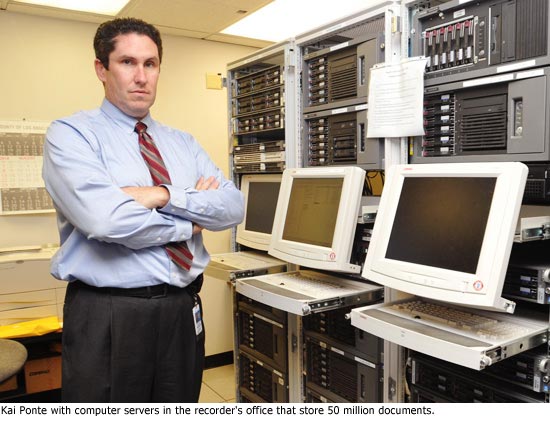
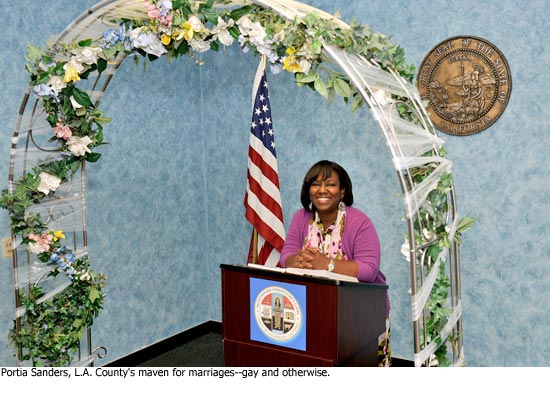
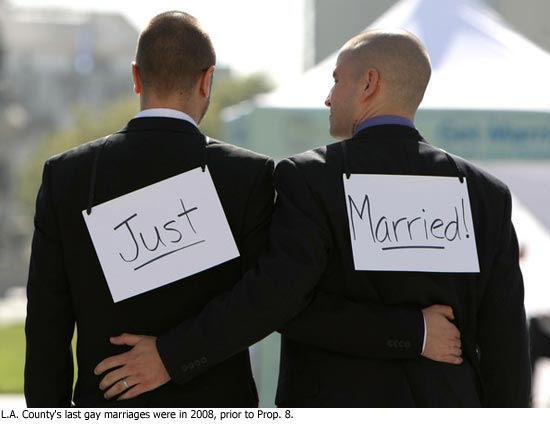


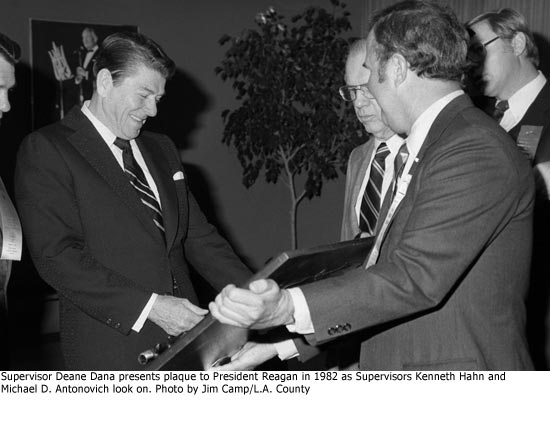










 405 bridge work causes a stink
405 bridge work causes a stink
